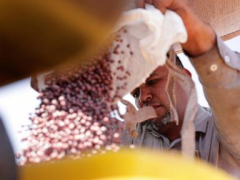SANTA CRUZ DO RIO PARDO, Brazil — Brazilian farmer Andrey Rodrigues wasn’t planning to beef up soybean production for next year’s harvest until a couple of months ago, but now he’s extra hopeful. What has him and his fellow Brazilian farmers planting more soybeans is the trade war between the Trump administration and China that has shut American soybeans out of the massive Chinese market.
China is actively seeking out Brazilian producers and the local trading companies that buy Rodrigues’ soybeans to sell to China have put the word out over the past two months that they will take all they can get, he said.
Just how much China will buy from Brazil remains to be seen, but China’s customs body said it did not import any soybeans from the U.S. in September. It’s the first time that’s happened since November 2018 when President Donald Trump launched his first trade war with China. Brazilian beans already accounted for more than 70% of China’s imports last year while the U.S. share was down to 21% even before the current trade dispute began, World Bank data shows.
Rodrigues, who chairs the soybean farmers association in Brazil’s powerhouse Sao Paulo state, is ramping up production at his Morada do Sol farm in the city of Santa Cruz do Rio Pardo.
The U.S.-China trade war “opens an opportunity for us here,” said Rodrigues, as he kicked off the highly mechanized process on his farm on a recent sunny day. “We need to be very aware in moments like this. Try to sell futures for the next harvest, seize this chance now.”
Brazil’s government said that between January and August, 77 million metric tons of soybeans were exported to China. That represents most of the South American country’s first season harvest.
During that period, China imported 17 million metric tons from the U.S., according to China’s customs data.
As the U.S. soybean harvest begins, there’s no indication that China is buying American.
The number of cargo ships carrying U.S. grains and docking at a major Chinese grains port fell 56% between January and September this year over the same period the previous year, or from 72 to 32, according to a social media account of the state broadcaster China Central Television. The number has fallen to zero since July.
By comparison, that port received an average of more than 40 cargo ships from countries such as Argentina, Brazil and Uruguay since May, and 90% of the cargo was soybeans, according to the state broadcaster’s post.
“China comes to us because of prices. Whenever they have higher tariffs in a given country, they come to us,” said Rodrigues.
The American Soybean Association said that China’s retaliatory ta





